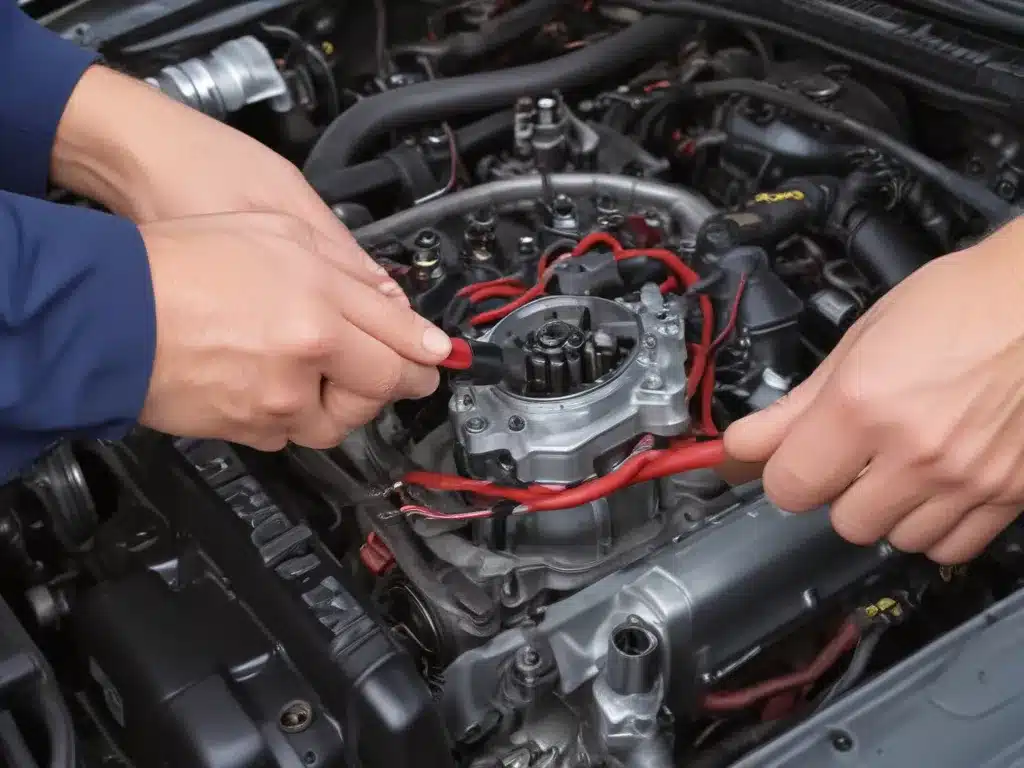
The Mysterious Misfire: Unraveling the Secrets of Your Car’s Ignition
I’ll never forget the day my trusty old sedan started acting up. One moment, I was cruising down the highway, minding my own business, and the next, the engine was sputtering and coughing like an asthmatic on a treadmill. Panic set in as I frantically searched for a safe place to pull over, wondering what on earth could be wrong with my beloved car.
As I popped the hood and peered at the mysterious innards, I realized that diagnosing and troubleshooting an ignition system issue was no easy feat. It’s a complex web of components, all working in harmony to ensure my car starts up and runs smoothly. But with a little bit of elbow grease and a whole lot of curiosity, I was determined to get to the bottom of this automotive enigma.
Ignition System 101: Understanding the Basics
The ignition system is the heart of your car’s engine, responsible for sparking the air-fuel mixture in each cylinder at the perfect moment. It’s a dance of electronic wizardry, orchestrated by a complex network of sensors, coils, and spark plugs.
Let’s break it down, shall we? The ignition system starts with the battery, which provides the necessary voltage to power the whole shebang. The ignition coil then steps up that voltage, creating a high-voltage spark that jumps across the spark plug’s electrodes, igniting the air-fuel mixture. This controlled explosion is what propels your car forward, one smooth stride at a time.
But it’s not just the coil and the spark plugs that keep the party going. There’s also the ignition module, which acts as the conductor, orchestrating the timing and duration of those sparks. And let’s not forget the crankshaft position sensor, which tells the module exactly when to fire up those cylinders.
Troubleshooting the Ignition System: Where to Begin?
Now, when something goes wrong with this delicate dance, it can be a real head-scratcher. That’s where troubleshooting comes in – it’s like being a car-whisperer, deciphering the unique language of your vehicle’s ignition system.
The first step is to listen closely to your car. Is it misfiring? Struggling to start? Losing power? These symptoms can provide valuable clues about where the problem lies. Once you’ve identified the issue, it’s time to start narrowing down the possible culprits.
Diagnosing Common Ignition System Problems
Spark Plug Issues
One of the most common ignition system woes is a problem with the spark plugs. These little guys are responsible for generating the spark that ignites the air-fuel mixture, and if they’re not functioning properly, you’re going to have some serious issues.
Signs of a spark plug problem include rough idling, decreased fuel efficiency, and even complete engine failure. To troubleshoot this, you can try removing and inspecting the plugs – look for signs of wear, damage, or improper gaps. If they’re not up to snuff, a quick replacement should get you back on the road.
Ignition Coil Troubles
Another potential culprit in the ignition system saga is the ignition coil. This component is responsible for stepping up the battery voltage to the high levels needed to create a spark. If the coil is malfunctioning, you might notice misfiring, hesitation, or even a complete engine shutdown.
Diagnosing a bad coil can be a bit tricky, as the symptoms can sometimes mimic other issues. One way to test it is by using a multimeter to check the coil’s resistance. If it’s outside the manufacturer’s specifications, you’ll know it’s time for a replacement.
Sensor Snafus
The ignition system relies on a delicate dance of sensors to keep everything in sync. The crankshaft position sensor, for instance, tells the ignition module when to fire the spark plugs. If this sensor is on the fritz, you might experience erratic engine behavior, including stalling, hesitation, or even a no-start condition.
Troubleshooting sensor issues can be a bit more involved, as it may require specialized diagnostic tools to pinpoint the problem. But by methodically testing each sensor and verifying the wiring connections, you can usually get to the root of the issue.
Wiring Woes
Finally, don’t forget about the often-overlooked wiring in your car’s ignition system. These delicate threads are the nervous system, carrying the vital signals and voltages throughout the system. If there’s a break, short, or loose connection, it can wreak havoc on your engine’s performance.
Tracking down wiring problems can be a real detective work, as the symptoms can be frustratingly vague. But with a keen eye, a multimeter, and a bit of patience, you can usually trace the issue back to a specific wire or connector.
Preventative Maintenance: Keeping Your Ignition System Healthy
Of course, the best way to avoid the headache of ignition system troubleshooting is to stay on top of your car’s preventative maintenance. Regular tune-ups, including spark plug replacements and coil inspections, can go a long way in keeping your engine running like a well-oiled machine.
And let’s not forget about the importance of routine oil changes. Autooilandfluid.com has a wealth of information on the importance of proper oil maintenance, and how it can impact the overall health of your car’s ignition system. After all, a well-lubricated engine is a happy engine, and a happy engine means a happy driver.
Conclusion: Mastering the Ignition System Enigma
Troubleshooting your car’s ignition system may seem like a daunting task, but with a little bit of know-how and a whole lot of determination, you can become a bona fide automotive detective. By understanding the basic components and common issues, you’ll be well on your way to diagnosing and resolving those pesky ignition woes.
And remember, prevention is the best medicine. Stay on top of your car’s maintenance, and you’ll be cruising down the road without a care in the world. Happy motoring, my friends!


